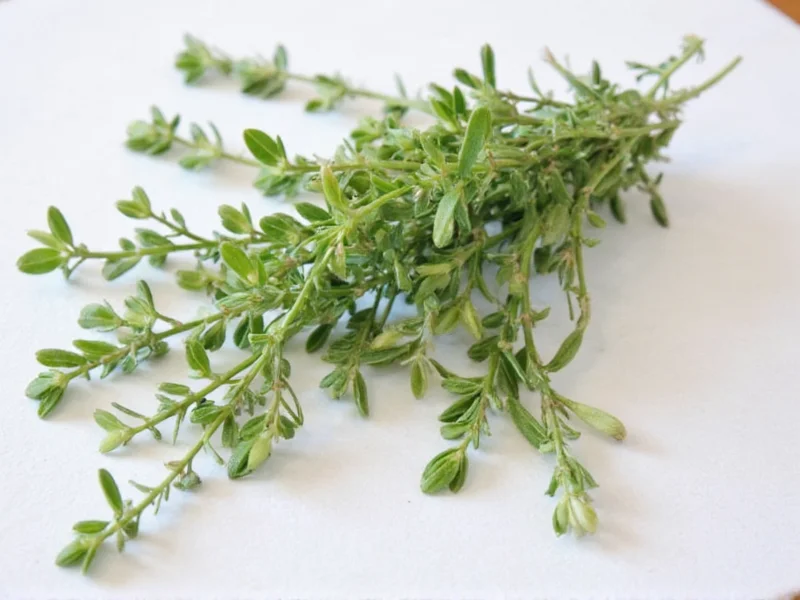Understanding thyme sprig measurements is essential for precise cooking and baking. This small but mighty herb stem appears in countless recipes, yet many home cooks struggle with accurate conversion and usage. A standard thyme sprig measures 2-4 inches in length with multiple leaf clusters along a thin, woody stem. When recipes call for "a sprig of thyme," they're referring to this entire stem unit rather than a specific weight or volume measurement.
What Exactly Is a Thyme Sprig?
Thyme grows in small, woody-stemmed plants with tiny leaves clustered along the stems. A single sprig represents one of these stems harvested from the plant. Unlike flat-leaf herbs like basil or parsley, thyme's diminutive size means multiple sprigs are needed to yield significant leaf volume. The sprig's thickness varies by thyme variety—English thyme produces sturdier stems than French or lemon thyme varieties.
Thyme Sprig Measurement Guide
Accurate measurement matters because thyme's potency affects dish flavor significantly. Here's a practical conversion chart for common cooking scenarios:
| Measurement | Fresh Thyme | Dried Thyme |
|---|---|---|
| 1 sprig | ¼-½ tsp stripped leaves | ⅛ tsp |
| 1 tablespoon | 4-6 sprigs | 1 tsp |
| 1 ounce (28g) | Approx. 30 sprigs | 2 tablespoons |
| Recipe substitution | 3 parts fresh | 1 part dried |
How to Prepare Thyme Sprigs for Cooking
Professional chefs use two primary methods to harvest thyme leaves from sprigs. The first technique involves holding the sprig upside down and running your fingers from the top toward the stem base, which efficiently strips leaves while leaving the tough stem behind. Alternatively, you can use kitchen shears to snip leaves directly from the stem. Always remove thyme leaves before serving dishes unless the recipe specifically calls for whole sprigs during cooking—nobody wants to bite into a woody stem.
When to Use Whole Sprigs vs. Stripped Leaves
Certain cooking applications benefit from using whole thyme sprigs. When preparing stocks, soups, or braises, chefs often add entire sprigs that can be easily removed before serving. The extended cooking time allows flavor extraction while preventing unpleasant texture in the final dish. For quick-cooking applications like sautés, omelets, or finishing sauces, always use stripped leaves for immediate flavor distribution and consistent texture.
Thyme Sprig Storage Techniques
Maximize freshness by treating thyme like cut flowers. Trim stem ends and place in a small glass with ½ inch of water, covering loosely with a plastic bag. Store in the refrigerator for up to two weeks. For longer preservation, freeze whole sprigs in olive oil using ice cube trays, or dry thyme by hanging sprigs upside down in a dark, well-ventilated space. Properly dried thyme maintains potency for 6-12 months when stored in airtight containers away from light.
Common Thyme Substitutions
When fresh thyme isn't available, oregano makes the closest flavor substitute in Mediterranean dishes, while marjoram works well in French cuisine. For every thyme sprig called for, use ¼ teaspoon dried oregano or marjoram. In a pinch, rosemary can substitute at half the quantity due to its stronger flavor profile. Remember that dried thyme requires rehydration—add it early in cooking to allow flavors to develop fully.
Professional Cooking Tips
Master chefs recommend adding fresh thyme at different cooking stages depending on the dish. For roasted meats, tuck whole sprigs under the skin for gradual flavor infusion. When making compound butter, finely mince thyme leaves to distribute flavor evenly. For delicate dishes like fish or eggs, use lemon thyme sprigs for a subtle citrus note. Always add dried thyme early in the cooking process while fresh thyme works best when added in the final 15 minutes to preserve its volatile oils.
How many teaspoons equal one thyme sprig?
One average thyme sprig yields approximately ¼ to ½ teaspoon of stripped leaves. The exact amount varies based on sprig size and thyme variety, with English thyme typically producing more leaves per sprig than French varieties.
Can I substitute dried thyme for fresh sprigs?
Yes, use one-third the amount of dried thyme when substituting for fresh. For example, if a recipe calls for 1 tablespoon fresh thyme (4-6 sprigs), use 1 teaspoon dried thyme. Add dried thyme earlier in cooking to allow proper rehydration and flavor development.
Why do recipes specify whole sprigs instead of measured amounts?
Recipes call for whole sprigs when the thyme will be removed before serving, such as in stocks, braises, or roasts. This method allows gradual flavor extraction while preventing woody stems in the final dish. It also accommodates natural variation in sprig size between growing seasons and regions.
How do I properly strip thyme leaves from stems?
Hold the sprig upside down by its top end and run your index finger and thumb firmly down the stem toward the base. The leaves will strip off cleanly while the tough stem remains intact. Alternatively, use kitchen shears to snip leaves directly from the stem, working from top to bottom.
Does thyme sprig size affect cooking time?
Yes, larger sprigs with more leaves require slightly longer cooking time to release their full flavor, especially when used whole in slow-cooked dishes. For quick-cooking applications, smaller sprigs or stripped leaves distribute flavor more rapidly. When substituting between thyme varieties, adjust quantities based on leaf density—lemon thyme typically has fewer leaves per sprig than common thyme.











 浙公网安备
33010002000092号
浙公网安备
33010002000092号 浙B2-20120091-4
浙B2-20120091-4